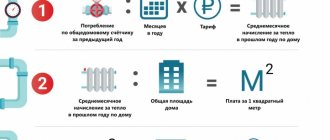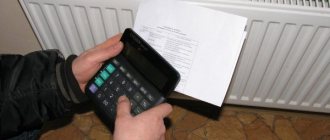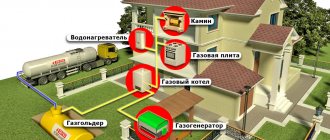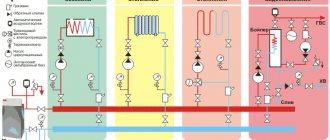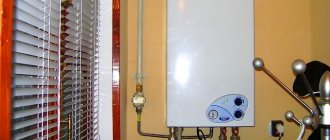The procedure for calculating heating in a residential building depends on the availability of metering devices and on the way in which the house is equipped with them. There are several options for equipping multi-apartment residential buildings with meters, and according to which thermal energy is calculated:
- the presence of a common building meter, while apartments and non-residential premises are not equipped with metering devices.
- Heating costs are controlled by a common house meter, and all or some rooms are equipped with metering devices.
- There is no general device for recording the consumption and consumption of thermal energy.
Before calculating the number of gigacalories spent, it is necessary to find out the presence or absence of controllers in the house and in each individual room, including non-residential ones. Let's consider all three options for calculating thermal energy, for each of which a specific formula has been developed (posted on the website of state authorized bodies).
Other ways to determine the amount of heat
Let us add that there are also other methods by which you can calculate the amount of heat that enters the heating system.
In this case, the formula is not only slightly different from those given below, but also has several variations. As for the values of the variables, they are the same as in the previous paragraph of this article. Based on all this, we can confidently conclude that it is quite possible to calculate the heat for heating on your own. However, one should not forget about consulting with specialized organizations that are responsible for providing housing with heat, since their methods and principles of calculations may differ, significantly, and the procedure may consist of a different set of measures.
If you intend to equip a “warm floor” system, then prepare for the fact that the calculation process will be more complex, since it takes into account not only the characteristics of the heating circuit, but also the characteristics of the electrical network, which, in fact, will heat the floor. Moreover, the organizations that install this kind of equipment will also be different.
Note! People often encounter the problem of converting calories into kilowatts, which is explained by the use of a unit of measurement in many specialized manuals, which is called “C” in the international system. >. In such cases, it is necessary to remember that the coefficient due to which kilocalories will be converted to kilowatts is 850
In simpler terms, one kilowatt is 850 kilocalories. This calculation option is simpler than those given above, since the value in gigacalories can be determined in a few seconds, since a Gcal, as noted earlier, is a million calories
In such cases, it is necessary to remember that the coefficient due to which kilocalories will be converted into kilowatts is equal to 850. In simpler terms, one kilowatt is 850 kilocalories. This calculation option is simpler than those given above, since the value in gigacalories can be determined in a few seconds, since a Gcal, as noted earlier, is a million calories.
In order to avoid possible mistakes, we should not forget that almost all modern heat meters operate with some error, albeit within acceptable limits. This error can also be calculated by hand, for which you need to use the following formula:
Traditionally, now we find out what each of these variable values means.
1. V1 is the flow rate of the working fluid in the supply pipeline.
2. V2 – a similar indicator, but in the return pipeline.
3. 100 is the number by which the value is converted to a percentage.
4. Finally, E is the error of the accounting device.
According to operational requirements and standards, the maximum permissible error should not exceed 2 percent, although in most meters it is somewhere around 1 percent.
As a result, we note that a correctly calculated Gcal for heating can significantly save money spent on heating the room. At first glance, this procedure is quite complicated, but - and you have seen this personally - if you have good instructions, there is nothing difficult about it.
That's all. We also recommend watching the thematic video below. Good luck in your work and, as usual, have a warm winter!
How to calculate the consumed thermal energy?
If for one reason or another there is no heat meter, then to calculate thermal energy you must use the following formula:
Vx(T1-T2)/1000=Q
Let's look at what these symbols mean.
1. V denotes the amount of hot water consumed, which can be calculated either in cubic meters or in tons.
2. T1 is the temperature indicator of the hottest water (traditionally measured in the usual degrees Celsius). In this case, it is preferable to use exactly the temperature that is observed at a certain operating pressure. By the way, the indicator even has a special name - enthalpy. But if the required sensor is missing, then as a basis you can take the temperature regime that is extremely close to this enthalpy. In most cases, the average is approximately 60-65 degrees.
3. T2 in the above formula also denotes the temperature, but of cold water. Due to the fact that it is quite difficult to penetrate the main line with cold water, constant values are used as this value, which can change depending on the climatic conditions outside. So, in winter, when the heating season is in full swing, this figure is 5 degrees, and in the summer, when the heating is turned off, 15 degrees.
4. As for 1000, this is the standard coefficient used in the formula in order to obtain the result in gigacalories. It will be more accurate than if you used calories.
5. Finally, Q is the total amount of thermal energy.
As you can see, there is nothing complicated here, so we move on. If the heating circuit is of a closed type (and this is more convenient from an operational point of view), then the calculations must be made slightly differently. The formula that should be used for a building with a closed heating system should look like this:
((V1x(T1-T)-(V2x(T2-T))=Q
Now, accordingly, to the decoding.
1. V1 indicates the flow rate of the working fluid in the supply pipeline (typically, not only water, but also steam can act as a source of thermal energy).
2. V2 is the flow rate of the working fluid in the return pipeline.
3. T is an indicator of the temperature of a cold liquid.
4. T1 – water temperature in the supply pipeline.
5. T2 – temperature indicator that is observed at the outlet.
6. And finally, Q is the same amount of thermal energy.
It is also worth noting that the calculation of Gcal for heating in this case depends on several notations:
- thermal energy that entered the system (measured in calories);
- temperature indicator during the removal of working fluid through the return pipeline.
What is Gcal
We should start with a related definition. A calorie refers to the specific amount of energy required to heat one gram of water to one degree Celsius (at atmospheric pressure, of course). And due to the fact that from the point of view of heating costs, say, at home, one calorie is a tiny amount, gigacalories (or Gcal for short), corresponding to one billion calories, are used for calculations in most cases. We've decided on this, let's move on.
The use of this value is regulated by the relevant document of the Ministry of Fuel and Energy, published back in 1995.
Note! On average, the consumption standard in Russia per square meter is 0.0342 Gcal per month. Of course, this figure may vary for different regions, since everything depends on climatic conditions
So, what is a gigacalorie if we “transform” it into values that are more familiar to us? See for yourself.
1. One gigacalorie is equal to approximately 1,162.2 kilowatt-hours.
2. One gigacalorie of energy is enough to heat a thousand tons of water to +1°C.
Initial data for thermal calculation of the heating system
Before you start calculating and working with data, you need to obtain it
Here, for those owners of country houses who have not previously been involved in design activities, the first problem arises - what characteristics are worth paying attention to. For your convenience, they are summarized in a small list below.
- Building area, ceiling height and internal volume.
- Type of building, presence of adjacent buildings.
- Materials used in the construction of the building - what and how the floor, walls and roof are made of.
- The number of windows and doors, how they are equipped, how well they are insulated.
- For what purposes will these or those parts of the building be used - where the kitchen, bathroom, living room, bedrooms will be located, and where - non-residential and technical premises.
- Duration of the heating season, average minimum temperature during this period.
- “Wind rose”, the presence of other buildings nearby.
- An area where a house has already been built or is about to be built.
- Preferred temperature for residents in certain rooms.
- Location of points for connecting to water supply, gas and electricity.
Other methods for calculating Gcal for heating
You can calculate the amount of heat that enters the heating system in other ways. For example, the formula for calculating Gcal can have two other forms:
- Q = ((V1 * (T1 - T2)) + (V1 - V2) * (T2 - T)) / 1000.
- Q = ((V2 * (T1 - T2)) + (V1 - V2) * (T1 - T)) / 1000.
All values in these formulas are the same as in the previous formula. Based on the above calculations, we can conclude that you can calculate Gcal for heating yourself. But you should seek advice from special companies that are responsible for supplying heat to the house, since their work and calculation system may differ from these formulas and consist of a different set of measures.
Many residents have difficulty converting kilocalories to kilowatts. This is due to many manuals of measuring units in the international system, which is called “C”. When converting kilocalories to kilowatts, the coefficient 850 should be used. That is, 1 kW equals 850 kcal. This calculation is much simpler than others, since it is not difficult to find out the required volume of gigacalories. 1 gigacalorie = 1 million calories.
During the calculation, it should be remembered that any modern devices have a small error. Mostly they are acceptable. But you need to calculate the error yourself. For example, this can be done using the following formula: R = (V1 - V2) / (V1+V2) * 100, where:
- R – error of a common house heating device.
- V1 and V2 are the previously indicated water flow parameters in the system.
- 100 is the coefficient that is responsible for converting the resulting value into a percentage. In accordance with operational standards, the maximum error that can be is 2%. Basically, this figure does not exceed 1%.
Simple area calculations
You can calculate the size of heating batteries for a specific room based on its area. This is the easiest way - to use plumbing standards, which stipulate that a thermal power of 100 W per hour is needed to heat 1 sq.m. We must remember that this method is used for rooms with standard ceiling heights (2.5-2.7 meters), and the result is somewhat inflated. In addition, it does not take into account such features as:
- number of windows and type of double-glazed windows on them;
- the number of external walls in the room;
- the thickness of the building walls and what material they are made of;
- type and thickness of insulation used;
- temperature range in a given climate zone.
The heat that radiators must provide to heat the room: the area should be multiplied by the thermal power (100 W). For example, for a room of 18 sq.m the following power of the heating battery is required:
18 sq.m x 100 W = 1800 W
That is, 1.8 kW of power is needed per hour to heat 18 square meters. This result must be divided by the amount of heat that the heating radiator section produces per hour. If the data in his passport indicates that this is 170 W, then the next stage of the calculation looks like this:
1800 W / 170 W = 10.59
This number must be rounded to the nearest whole number (usually rounded up) - it will be 11. That is, in order for the temperature in the room to be optimal during the heating season, it is necessary to install a heating radiator with 11 sections.
This method is only suitable for calculating the battery size in rooms with central heating, where the coolant temperature is not higher than 70 degrees Celsius.
There is a simpler method that can be used for normal apartment conditions in panel houses. This approximate calculation takes into account that one section is needed to heat 1.8 square meters of area. In other words, the area of the room must be divided by 1.8. For example, with an area of 25 sq.m., 14 parts are needed:
25 sq.m / 1.8 sq.m = 13.89
But this calculation method is unacceptable for a radiator of reduced or increased power (when the average output of one section varies from 120 to 200 W).
Option 2
Now we will calculate payments in conditions where the house is equipped with a common heating meter, and some of the apartments are also equipped with individual meters. As in the previous case, the calculation will be carried out according to two positions (thermal energy consumption for housing and ODN).
We will need formula No. 1 and No. 2 (accrual rules according to controller readings or taking into account heat consumption standards for residential premises in Gcal). Calculations will be carried out relative to the area of the residential building and apartment from the previous version.
Calculation 1
- 1.3 gigacalories – individual meter readings;
- RUR 1,1820 – approved tariff.
https://youtube.com/watch?v=dFLW96z0YVk
- Is 0.025 Gcal a standard indicator of heat consumption per 1 m2? area in the apartment;
- 70 m? – square footage of the apartment;
- 1,400 rub. – tariff for thermal energy.
Next, we calculate the second component of our payment (ODN) using two formulas - No. 13 (volume of service) and No. 10 (heating cost).
Calculation 2
- 300 gcal – readings of the common house meter;
- 12 Gcal – the amount of thermal energy used to heat non-residential premises;
- 6,000 m? – the sum of the area of all residential premises;
- 0.025 – standard (heat energy consumption for apartments);
- 9 Gcal – the sum of indicators from the meters of all apartments that are equipped with metering devices;
- 35 Gcal – the amount of heat spent on supplying hot water in the absence of a centralized supply;
- 70 m? – area of the apartment;
- 8,000 m? – total area (all residential and non-residential premises in the house).
https://youtube.com/watch?v=tGvIg-I1QCU
Please note that this option includes only the actual volumes of energy consumed and if your house is equipped with a centralized hot water supply, then the amount of heat spent on hot water supply needs is not taken into account. The same applies to non-residential premises: if they are not in the house, then they will not be included in the calculation
- 1.425 gcal – amount of heat (AT);
- 1,400 rub. – approved tariff.
As a result of the calculations, we found out that the full payment for heating will be:
- 1820 + 1995 = 3,815 rubles. - with an individual counter.
- 2,450 + 1995 = 4,445 rubles. - without an individual device.
Calculation of heating radiators per square meter
Despite the diversity of the heating systems market, radiators always remain in trend. However, owners of heating equipment often make mistakes in its operation. The most common is the discrepancy between the heat transfer of the battery and the area of the room. The simplest way to calculate a battery is 100 W per 1 m2. Knowing the area of the room, multiply it by 100.
If the radiator is multi-sectional, then use the formula: N = Q/ Qс, where N is the number of sections, and Qс is the power of each section separately. If the ceiling height exceeds 2.7 m, use the volume calculation. For more accurate information on heat transfer, you can use the following coefficients:
- Number of external walls (Cf. 1.1, 1.2);
- Orientation of the room to the cardinal directions (Cf. 1.1, if to the north and east);
- Wall insulation coefficient (0.85, 1, 1.27);
- Climatic conditions (-35° - Kf. 1.5, -25° - Kf. 1.3, -15° - Kf. 1.1, -10° - Kf. 0.7);
- Ceiling height (Cf. From 1 to 1.2);
- Apartment floor (Cf. From 1 to 0.8);
Type of window frame (wooden -1.27, single-layer glass - 1, double glass - 0.85);
Q = S × 100 ×… (coefficient value)
Counters of different types
Calculation of heating fees has some peculiarities if a multi-storey building has a common measuring device and separate meters for measuring the amount of heat in all apartments (this applies not only to residential premises). The main thing is to clarify the availability of metering devices in all apartments.
In the case under consideration, the formula includes the following indicators. They take the volume of heat used in a specific facility (applies to residential and non-residential premises). It is determined on the basis of indicators taken from individual or general meters related to the apartment metering device. The amount of communal resource is determined, thanks to which the general house needs are satisfied. At the same time, they are equipped with collective devices that make it possible to accurately take into account the consumed thermal energy.
The total area of the building, which contains many apartments belonging to residential or non-residential real estate, is taken into account, as well as the total area in a separate individual object located in this multi-apartment building. Be sure to take into account the cost of heat for each region.
The payment can be made if the following calculations are made: the area of the apartment is divided by the area of the house and multiplied by the amount of energy provided for the total needs of the entire building with apartments. Then sum it up with the amount of energy consumed in the first room. In the last step, you need to multiply the resulting figure by the active tariff.
The essence of this payment option is that the amount of heat consumed by residents of one apartment increases by the part of the heat spent for general house needs.
If the final number is higher than the amount paid in advance, it will be counted toward the payment the person plans to make. If you get a smaller value, you will need to pay extra. The action is carried out on the basis of corrective mechanisms.
Heat meters
Now let’s find out what information is needed in order to calculate the heating. It's easy to guess what this information is.
1. Temperature of the working fluid at the outlet/inlet of a specific section of the pipeline.
2. The flow rate of the working fluid that passes through the heating devices.
Consumption is determined through the use of heat metering devices, that is, meters. These can be of two types, let’s get acquainted with them.
Vane meters
Such devices are intended not only for heating systems, but also for hot water supply. Their only difference from those meters that are used for cold water is the material from which the impeller is made - in this case it is more resistant to elevated temperatures.
As for the mechanism of operation, it is almost the same:
- due to the circulation of the working fluid, the impeller begins to rotate;
- the rotation of the impeller is transmitted to the accounting mechanism;
- transmission is carried out without direct interaction, but with the help of a permanent magnet.
Despite the fact that the design of such meters is extremely simple, their response threshold is quite low, moreover, there is reliable protection against distortion of readings: the slightest attempts to slow down the impeller through an external magnetic field are stopped thanks to an antimagnetic screen.
Devices with a difference recorder
Such devices operate on the basis of Bernoulli's law, which states that the speed of a gas or liquid flow is inversely proportional to its static movement. But how does this hydrodynamic property apply to calculations of working fluid flow? It’s very simple - you just need to block its path with a retaining washer. In this case, the rate of pressure drop on this washer will be inversely proportional to the speed of the moving flow. And if the pressure is recorded by two sensors at once, then the flow can be easily determined, and in real time.
Note! The design of the meter implies the presence of electronics. The vast majority of such modern models provide not only dry information (temperature of the working fluid, its consumption), but also determines the actual use of thermal energy. The control module here is equipped with a port for connecting to a PC and can be configured manually.
Many readers will probably have a logical question: what to do if we are not talking about a closed heating system, but about an open one, in which selection for hot water supply is possible? How to calculate Gcal for heating in this case? The answer is quite obvious: here pressure sensors (as well as retaining washers) are installed simultaneously on both the supply and the “return”. And the difference in the flow rate of the working fluid will indicate the amount of heated water that was used for domestic needs.
Calculation under other conditions
To calculate the payment for energy in the absence of meters in an apartment building, but in the presence of a common house appliance, you must follow the calculation procedure given below. Payment according to the described procedure is charged exclusively in those buildings where there are no meters in absolutely all apartments and non-residential premises.
The formula used involves first calculating the ratio of the total area of individual residential premises to the total area of residential premises. Next, the resulting value must be multiplied by the cost of thermal energy and by the number of gigacalories that were consumed during the estimated period of time. The amount of energy expended is determined based on the readings of a common household appliance.
If not all apartments are equipped with meters, but, for example, only 95%, the above algorithm can be used for calculation.
Payment for heat according to it in a simplified version is carried out using the total amount of thermal energy used in the house. The share of each apartment must be calculated. The resulting volume of heat consumed must be multiplied by the current tariff suitable for a particular region.
What is all this for?
The problem should be considered from two points of view - from the point of view of apartment buildings and private ones. Let's start with the first ones.
Apartment buildings
There is nothing complicated here: gigacalories are used in thermal calculations. And if you know how much thermal energy remains in the house, then you can present the consumer with a specific bill. Let's give a small comparison: if centralized heating operates in the absence of a meter, then you have to pay according to the area of the heated room. If there is a heat meter, this in itself implies a horizontal wiring type (either collector or serial): two risers are brought into the apartment (for “return” and supply), and the intra-apartment system (more precisely, its configuration) is determined by the residents. This kind of scheme is used in new buildings, thanks to which people regulate the consumption of thermal energy, making a choice between savings and comfort.
Let's find out how this adjustment is carried out.
1. Installation of a general thermostat on the return line. In this case, the flow rate of the working fluid is determined by the temperature inside the apartment: if it decreases, the flow rate will accordingly increase, and if it increases, it will decrease.
2. Throttling of heating radiators. Thanks to the throttle, the passage of the heating device is limited, the temperature decreases, and therefore the consumption of thermal energy is reduced.
Private houses
We continue to talk about calculating Gcal for heating. Owners of country houses are interested, first of all, in the cost of a gigacalorie of thermal energy obtained from one or another type of fuel. The table below may help with this.
Table. Comparison of cost of 1 Gcal (including transport costs)
| Name of energy resource | Approximate cost, in rubles* |
| Gas (liquefied) | 520 |
| Gas (natural) | 3 300 |
| Coal | 550 |
| Diesel fuel | 3 270 |
| Pellets | 1 800 |
| Electric Energy | 4 300 |
* - prices are approximate, since tariffs may differ depending on the region, moreover, they are constantly growing.
Formula for calculating Gcal for heating
If you do not have an individual device, then you need to use the following formula for calculating heat for heating: Q = V * (T1 – T2) / 1000, where:
- Q is the total amount of heat energy.
- V is the volume of hot water consumption. Measured in tons or cubic meters.
- T1 is the hot water temperature, measured in degrees Celsius. In such a calculation, it is better to take into account the temperature that will be characteristic of a specific operating pressure. This indicator is called enthalpy. If there is no necessary sensor, then take the temperature that will be similar to the enthalpy. Typically, the average temperature is between 60-65 degrees Celsius.
- T2 is the temperature of cold water, which is measured in degrees Celsius. As you know, getting to a pipeline with cold water is not easy, so such values are determined by constant values. They, in turn, depend on the climatic conditions outside the house. For example, in the cold season, this value can be 5 degrees, and in warm times, when there is no heating, it can reach 15 degrees.
- 1000 is a factor that gives the answer in gigacalories. This value will be more accurate than regular calories.
In a closed heating system, gigacalories are calculated in a different form. In order to calculate Gcal in a closed heating system, you must use the following formula: Q = ((V1 * (T1 - T)) - (V2 * (T2 - T))) / 1000, where:
- Q – previous volume of thermal energy;
- V1 is the heat carrier flow rate parameter in the supply pipe. The heat source can be water vapor or ordinary water.
- V2 – volume of water flow in the outlet pipe;
- T1 – temperature in the coolant supply pipe;
- T2 – temperature at the pipe outlet;
- T – cold water temperature.
Calculation of thermal energy for heating using this formula depends on two parameters: the first shows the heat that enters the system, and the second is the heat parameter when the coolant is removed through the return pipe.
Hydraulic calculation
So, the heat loss has been determined, the power of the heating unit has been selected, all that remains is to determine the volume of the required coolant, and, accordingly, the dimensions, as well as the materials of the pipes, radiators and shut-off valves used.
First of all, we determine the volume of water inside the heating system. This requires three indicators:
- Total power of the heating system.
- Temperature difference at the outlet and inlet of the heating boiler.
- Heat capacity of water. This figure is standard and equal to 4.19 kJ.
Hydraulic calculation of the heating system
The formula is as follows: divide the first indicator by the last two. By the way, this type of calculation can be used for any part of the heating system
Here it is important to divide the line into parts so that in each the speed of movement of the coolant is the same. Therefore, experts recommend making a breakdown from one shut-off valve to another, from one heating radiator to another
Now we move on to calculating coolant pressure losses, which depend on friction inside the pipe system. To do this, only two quantities are used, which are multiplied together in the formula. This is the length of the main section and specific friction losses.
But pressure losses in shut-off valves are calculated using a completely different formula. It takes into account indicators such as:
- Coolant density.
- Its speed in the system.
- The total indicator of all coefficients that are present in this element.
In order for all three indicators, which are derived by formulas, to fit standard values, it is necessary to select the correct pipe diameters. For comparison, we will give an example of several types of pipes to make it clear how their diameter affects the heat output.
- Metal-plastic pipe with a diameter of 16 mm. Its thermal power varies in the range of 2.8-4.5 kW. The difference in the indicator depends on the temperature of the coolant. But keep in mind that this is a range where the minimum and maximum values are set.
- The same pipe with a diameter of 32 mm. In this case, the power varies between 13-21 kW.
- Polypropylene pipe. Diameter 20 mm - power range 4-7 kW.
- The same pipe with a diameter of 32 mm - 10-18 kW.
And the last thing is the definition of a circulation pump. In order for the coolant to be evenly distributed throughout the heating system, it is necessary that its speed be no less than 0.25 m/sec and no more than 1.5 m/sec. In this case, the pressure should not be higher than 20 MPa. If the coolant velocity is higher than the maximum suggested value, the pipe system will operate noisily. If the speed is lower, airing of the circuit may occur.
Common parameters
In practice, it turns out that calculating the cost of heating is not such a simple procedure that you have to familiarize yourself with over a certain period of time. Current legislation provides for different options for making calculations depending on a number of factors, including the presence of a meter, time of year and many other parameters.
It is worth noting the fact that certain regions and local governments may establish their own rules for conducting calculations, which may supplement already adopted general legislative acts.
Thus, three main charging options can be distinguished:
- there are no devices in the house that provide heat energy metering;
- the calculation is carried out in accordance with the indicators of the heat meter installed to service a multi-storey building;
- the calculation is carried out in accordance with the indicators of the heat meter installed in each individual apartment.
We calculate the heat consumption by quadrature
To roughly estimate the heating load, the simplest thermal calculation is usually used: take the outside area of the building and multiply it by 100 W. Accordingly, the heat consumption of a 100 m² country house will be 10,000 W or 10 kW. The result allows you to select a boiler with a safety factor of 1.2-1.3; in this case, the power of the unit is taken to be 12.5 kW.
We propose to perform more accurate calculations that take into account the location of rooms, the number of windows and the region of development. So, for ceiling heights up to 3 m, it is recommended to use the following formula:
The calculation is carried out for each room separately, then the results are summed up and multiplied by the regional coefficient. Explanation of formula symbols:
- Q – required load value, W;
- Spom – square footage of the room, m²;
- q – indicator of specific thermal characteristics, related to the area of the room, W/m²;
- k is a coefficient that takes into account the climate in the area of residence.
For reference. If a private house is located in a temperate climate zone, the coefficient k is taken equal to one. In the southern regions k = 0.7, in the northern regions values of 1.5–2 are used.
In an approximate calculation based on the total quadrature, the indicator q = 100 W/m². This approach does not take into account the location of the rooms and the different number of light openings. The corridor located inside the cottage will lose much less heat than a corner bedroom with windows of the same area. We propose to take the value of the specific thermal characteristic q as follows:
- for rooms with one external wall and a window (or door) q = 100 W/m²;
- corner rooms with one light opening - 120 W/m²;
- the same, with two windows – 130 W/m².
How to correctly select the value of q is clearly shown on the building plan. For our example, the calculation looks like this:
Q = (15.75 x 130 + 21 x 120 + 5 x 100 + 7 x 100 + 6 x 100 + 15.75 x 130 + 21 x 120) x 1 = 10935 W ≈ 11 kW.
As you can see, the refined calculations gave a different result - in fact, 1 kW more thermal energy will be consumed to heat a particular 100 m² house. The figure takes into account the heat consumption to heat the outside air entering the home through openings and walls (infiltration).
Important Calculations
How is heating in an apartment calculated? The corresponding government decree approves the procedure for payments and submission of documents. There is a certain procedure for providing utility services to owners of apartments and residential buildings. Another resolution approved the rules for providing similar services to all citizens of the Russian Federation.
When faced with the question of how to calculate the heating fee, you must be guided by the rules adopted initially and in a later version. Although only the latest version for 2011 should be used, the period associated with the transition to it continues. Local government authorities at the regional level determine the list of required documents that must be followed.
How to calculate payment for heating according to the rules established by Resolution No. 354? The provided procedure determines the collection of payments not for the entire year, but only for the heating period. If the subject’s place of residence is the Moscow region, and charges for heat are made only during the period from October to May, then you can safely be guided by the information provided. If the number of months is different, you must follow the rules established by Resolution No. 307.
Payments only during heating seasons makes the calculation process much simpler and more convenient. This is a significant achievement and a plus for residents. In practice, it becomes clear that the heating fee established at a later period for residential premises is slightly higher than the amount accepted earlier. This is due to the fact that payments were divided over all 12 months. In most cases this leads to inconvenience.
How is the payment for heat in apartments calculated? The calculation algorithm is influenced by a number of factors. Among them are:
- the presence of one meter in residential premises (apartment buildings);
- the presence of heat meters in every apartment and non-residential premises;
- the presence of distributors (they should be in half of the non-residential and residential premises of an apartment building).
Calculation of standard heat consumption
Dear Igor Viktorovich!
I asked your specialists for data on determining standards for heat consumption. The answer was received. But I also contacted MPEI, where they also provided a link to the calculations. I quote it:
Borisov Konstantin Borisovich.
Moscow Energy Institute (Technical University)
To calculate the standard heat consumption for heating, you must use the following document:
Resolution No. 306 “Rules for establishing and determining utility consumption standards; Table 7 - “The value of the standardized specific heat energy consumption for heating an apartment building or residential building”).
To determine payment for heating for a residential premises (apartment), you must use the following document:
Resolution No. 307 “Rules for the provision of utility services to citizens” (Appendix No. 2 – “Calculation of the amount of payment for utility services”, formula 1).
In principle, the calculation of the standard heat consumption for heating an apartment and determining the payment for heating is not difficult.
If you want, let's try to roughly (roughly) estimate the main numbers:
1) The maximum hourly heating heat load of your apartment is determined:
Qmax = Qsp*Sq = 74*74 = 5476 kcal/h
Where
Qsp = 74 kcal/h - standardized specific heat energy consumption for heating 1 sq.
m of apartment building.
The value of Qd is taken according to Table 1 for buildings built before 1999, with a height (number of floors) of 5-9 floors at an outside air temperature of Tnro = -32 C (for the city K).
Sq = 74 sq. m – the total area of the apartment premises.
2) Calculate the amount of thermal energy required to heat your apartment during the year:
Qsr = Qmax×[(Tv-Tsr.o)/(Tv-Tnro)]×No×24 = 5476×[(20-(-5.2))/(20-(-32))]×215* 24=13,693,369 kcal = 13.693 Gcal
Where
TV = 20 C – standard value of internal air temperature in residential premises (apartments) of the building;
Тср.о = -5.2 С - outside air temperature, average for the heating period (for city K);
No = 215 days - the duration of the heating period (for city K).
3) The standard for heating 1 square meter is calculated. meters:
Option 1
So, the house is equipped with a control device, but some rooms are left without it
Here it is necessary to take into account two positions: calculating Gcal for heating an apartment, the cost of thermal energy for general house needs (GCA)
In this case, formula No. 3 is used, which is based on the readings of the general metering device, the area of the house and the footage of the apartment.
Calculation example
Let's assume that the controller has recorded the house's heating costs at 300 Gcal/month (this information can be found from the receipt or by contacting the management company). For example, the total area of the house, which consists of the sum of the areas of all premises (residential and non-residential), is 8000 m? (you can also find out this figure from the receipt or from the management company).
Now you can move on to the second stage of accounting for heating costs spent on the general needs of the house. Here you will need two formulas: searching for the volume of service (No. 14) and payment for the consumption of gigacalories in rubles (No. 10).
For example, we have a total footage of 7000 m? (including apartments, offices, retail premises.).
- 0.375 – volume of service for heat supply;
- 1400 rub. – tariff;
- 525 rub. - amount of payment.
We sum up the results (1875 + 525) and find out that the payment for heat consumption will be 2350 rubles.
Average calculation and accurate
Taking into account the described factors, the average calculation is carried out according to the following scheme. If per 1 sq. m requires 100 W of heat flow, then a room of 20 sq. m should receive 2,000 watts. A radiator (popular bimetallic or aluminum) of eight sections produces about 150 W. Divide 2,000 by 150, we get 13 sections. But this is a rather enlarged calculation of the thermal load.
The exact one looks a little scary. Nothing complicated really. Here's the formula:
- q1 – type of glazing (regular = 1.27, double = 1.0, triple = 0.85);
- q2 – wall insulation (weak or absent = 1.27, wall laid with 2 bricks = 1.0, modern, high = 0.85);
- q3 – ratio of the total area of window openings to the floor area (40% = 1.2, 30% = 1.1, 20% - 0.9, 10% = 0.8);
- q4 – street temperature (the minimum value is taken: -35 o C = 1.5, -25 o C = 1.3, -20 o C = 1.1, -15 o C = 0.9, -10 o C = 0.7);
- q5 – number of external walls in the room (all four = 1.4, three = 1.3, corner room = 1.2, one = 1.2);
- q6 – type of calculation room above the calculation room (cold attic = 1.0, warm attic = 0.9, heated residential room = 0.8);
- q7 – ceiling height (4.5 m = 1.2, 4.0 m = 1.15, 3.5 m = 1.1, 3.0 m = 1.05, 2.5 m = 1.3).
Using any of the described methods, you can calculate the heat load of an apartment building.
Methodology for calculating thermal energy for heating
The procedure for calculating heating in a residential building depends on the availability of metering devices and on the way in which the house is equipped with them. There are several options for equipping multi-apartment residential buildings with meters, and according to which thermal energy is calculated:
- the presence of a common building meter, while apartments and non-residential premises are not equipped with metering devices.
- Heating costs are controlled by a common house meter, and all or some rooms are equipped with metering devices.
- There is no general device for recording the consumption and consumption of thermal energy.
Before calculating the number of gigacalories spent, it is necessary to find out the presence or absence of controllers in the house and in each individual room, including non-residential ones. Let's consider all three options for calculating thermal energy, for each of which a specific formula has been developed (posted on the website of state authorized bodies).
Legal grounds for recalculating heat load
The right of consumers to calculate heat loads is secured
- in each standard contract for the supply of thermal energy, as well as
- in the order of the Ministry of Regional Development of the Russian Federation dated December 28, 2009 No. 610 “On approval of the rules for establishing and changing (revising) heat loads.”
Order No. 610 of the Ministry of Regional Development establishes that in order to revise contractual values, it is necessary to develop a technical report with calculations of heat loads.
The report must justify the change or reduction in the thermal load for the facility.
Also, Order No. 610 establishes that the calculation of the heat load for heating, ventilation and hot water supply can be revised after the implementation of energy-saving measures, namely, after:
- major repairs,
- reconstruction of internal engineering networks, which helps reduce losses through insulation and leaks,
- increasing the thermal protection of a building or facility,
- implementation of other energy-saving measures.
Here you can download the order of the Ministry of Regional Development of the Russian Federation dated December 28, 2009 No. 610 “On approval of the rules for establishing and changing (revising) heat loads.”
Results of calculations of Gcal for heating
If you have correctly calculated the consumption of Gcal of thermal energy, then you do not have to worry about overpayments for utilities. If we use the above formulas, we can conclude that when heating a residential building with an area of up to 200 sq.m. you will need to spend about 3 Gcal in 1 month. If we consider that the heating season in many regions of the country lasts approximately 6 months, then we can calculate the approximate consumption of thermal energy. To do this, multiply 3 Gcal by 6 months and get 18 Gcal.
It is much easier to calculate gigacalorie consumption in a private home, since you can install your own individual device there. In apartment buildings with centralized heating, it will not be possible to get by with a conventional appliance.
Based on the information indicated above, we can conclude that all calculations on the consumption of thermal energy in a particular house can be done independently without the help of special organizations. But it is worth remembering that all data must be calculated accurately using special mathematical formulas. In addition, all procedures must be coordinated with special bodies that control such actions. If you are not sure that you will perform the calculation yourself, then you can use the services of professional specialists who are engaged in such work and have materials available that describe in detail the entire process and photos of heating system samples, as well as their connection diagrams.
(no votes yet)
An example of calculating the thermal loads of a commercial facility
This room is on the first floor of a 4-story building. Location: Moscow.
Initial data on the object
| Address of the object | Moscow |
| Number of floors of the building | 4 floors |
| The floor on which the premises being examined are located | first |
| Area of premises inspected | 112.9 sq.m. |
| Floor height | 3.0 m |
| Heating system | Single-pipe |
| Temperature chart | 95-70 degrees. WITH |
| Estimated temperature chart for the floor on which the room is located | 75-70 degrees. WITH |
| Bottling type | Upper |
| Estimated indoor air temperature | + 20 degrees C |
| Heating radiators, type, quantity | Cast iron radiators M-140-AO – 6 pcs. Bimetallic radiator Global (Global) – 1 pc. |
| Heating system pipe diameter | DN-25 mm |
| Heating system supply pipe length | L = 28.0 m. |
| DHW | absent |
| Ventilation | absent |
| Heat load according to the contract (hour/year) | 0.02/47.67 Gcal |
The calculated heat transfer of the installed heating radiators, taking into account all losses, was 0.007457 Gcal/hour.
The maximum heat energy consumption for heating the room was 0.001501 Gcal/hour.
The final maximum flow rate is 0.008958 Gcal/hour or 23 Gcal/year.
As a result, we calculate the annual savings for heating this room: 47.67-23 = 24.67 Gcal/year. This way you can cut your heating energy costs by almost half. And if we take into account that the current average cost of Gcal in Moscow is 1.7 thousand rubles, then the annual savings in monetary equivalent will be 42 thousand rubles.
